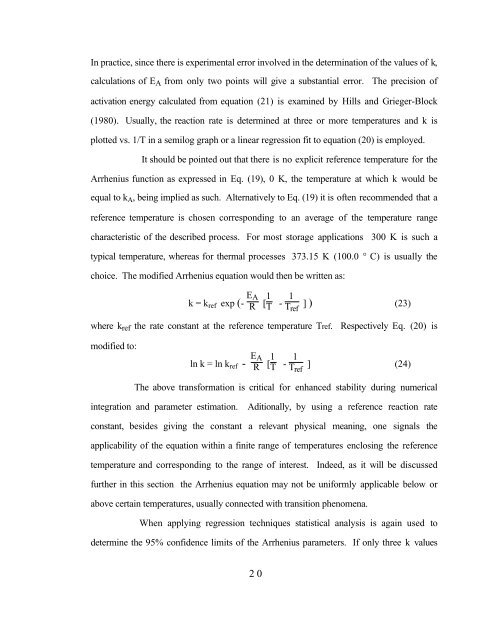the handbook of food engineering practice crc press chapter 10 ...
the handbook of food engineering practice crc press chapter 10 ...
the handbook of food engineering practice crc press chapter 10 ...
You also want an ePaper? Increase the reach of your titles
YUMPU automatically turns print PDFs into web optimized ePapers that Google loves.
In <strong>practice</strong>, since <strong>the</strong>re is experimental error involved in <strong>the</strong> determination <strong>of</strong> <strong>the</strong> values <strong>of</strong> k,<br />
calculations <strong>of</strong> E A from only two points will give a substantial error. The precision <strong>of</strong><br />
activation energy calculated from equation (21) is examined by Hills and Grieger-Block<br />
(1980). Usually, <strong>the</strong> reaction rate is determined at three or more temperatures and k is<br />
plotted vs. 1/T in a semilog graph or a linear regression fit to equation (20) is employed.<br />
It should be pointed out that <strong>the</strong>re is no explicit reference temperature for <strong>the</strong><br />
Arrhenius function as ex<strong>press</strong>ed in Eq. (19), 0 K, <strong>the</strong> temperature at which k would be<br />
equal to k A , being implied as such. Alternatively to Eq. (19) it is <strong>of</strong>ten recommended that a<br />
reference temperature is chosen corresponding to an average <strong>of</strong> <strong>the</strong> temperature range<br />
characteristic <strong>of</strong> <strong>the</strong> described process. For most storage applications 300 K is such a<br />
typical temperature, whereas for <strong>the</strong>rmal processes 373.15 K (<strong>10</strong>0.0 ° C) is usually <strong>the</strong><br />
choice. The modified Arrhenius equation would <strong>the</strong>n be written as:<br />
k = k ref exp (- E A<br />
R [ 1 T - 1<br />
T ref<br />
] ) (23)<br />
where k ref <strong>the</strong> rate constant at <strong>the</strong> reference temperature Tref. Respectively Eq. (20) is<br />
modified to:<br />
ln k = ln k ref - E A<br />
R [ 1 T - 1<br />
T ref<br />
] (24)<br />
The above transformation is critical for enhanced stability during numerical<br />
integration and parameter estimation. Aditionally, by using a reference reaction rate<br />
constant, besides giving <strong>the</strong> constant a relevant physical meaning, one signals <strong>the</strong><br />
applicability <strong>of</strong> <strong>the</strong> equation within a finite range <strong>of</strong> temperatures enclosing <strong>the</strong> reference<br />
temperature and corresponding to <strong>the</strong> range <strong>of</strong> interest. Indeed, as it will be discussed<br />
fur<strong>the</strong>r in this section <strong>the</strong> Arrhenius equation may not be uniformly applicable below or<br />
above certain temperatures, usually connected with transition phenomena.<br />
When applying regression techniques statistical analysis is again used to<br />
determine <strong>the</strong> 95% confidence limits <strong>of</strong> <strong>the</strong> Arrhenius parameters. If only three k values<br />
20














